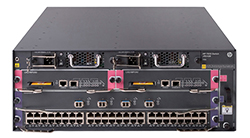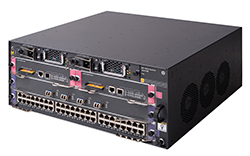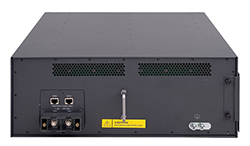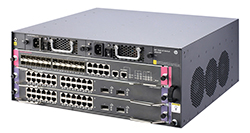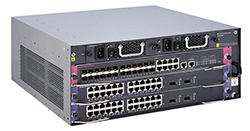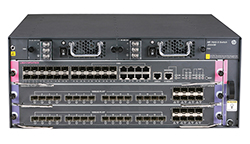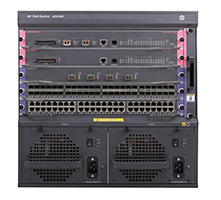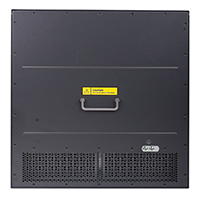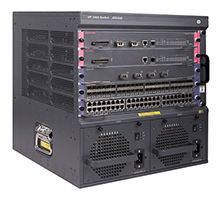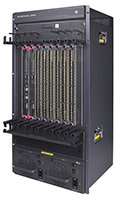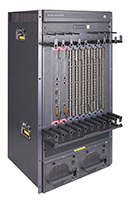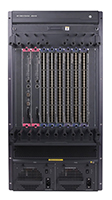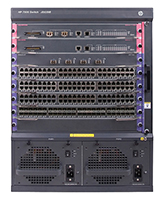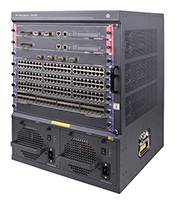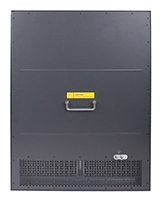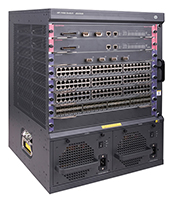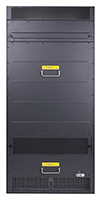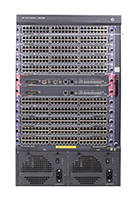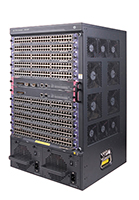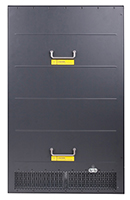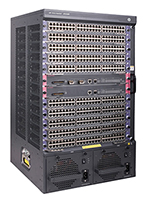
HP 7500 Switch Series
New generation of multilayer switches that meet the evolving needs of integrated services networks.
Please visit our Aruba Networks (HPE) site for the latest Aruba Networks' wireless products
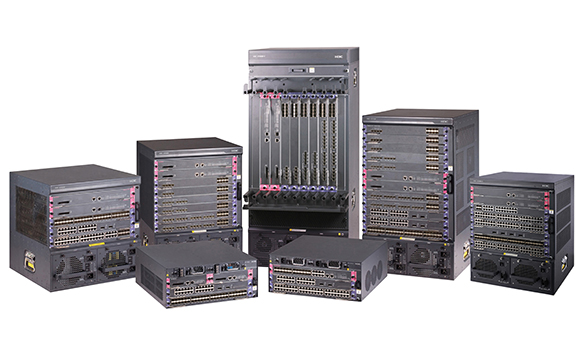
List Price:
Our Price: $2,769.00
List Price:
Our Price: $4,856.00
List Price:
Our Price: $6,245.00
Our Price: $14,770.00
Our Price: $17,850.00
HPE 7510 Switch Chassis
List Price:
Our Price: $22,950.00
List Price:
Our Price: $12,978.00
List Price:
Our Price: $16,530.00
List Price:
Our Price: $18,556.00
More pricing below, click here!
Overview:
The HP 7500 Switch Series is comprised of modular, multilayer chassis switches. These switches meet the evolving needs of integrated services networks and can be deployed in multiple network environments, including the enterprise LAN core, aggregation layer, and wiring closet edge. They offer 40GbE connectivity and cost-effective, wire-speed 10-Gigabit Ethernet ports to safeguard the throughput and bandwidth necessary for mission-critical data and high-speed communications. A passive backplane, support for load sharing, and redundant management and fabrics help the HP 7500 Switch Series offer high availability. Moreover, these switches deliver wire-speed Layer 2 and Layer 3 routing services for the most demanding applications with hardware-based IPv4 and IPv6 support.
- Versatile, high-performance modular switches
- Enterprise LAN core, aggregation, and edge
- Extensive switching and routing, IPv6, MPLS
- Advanced functionality with service modules
- Robust network and service virtualization
What's New
Ideal for enterprise campus deployments in the core, distribution or access layers, the 7500 series offers a flexible platform with a rich feature set.
- New value-added and easy to order bundle SKUs
- Includes up to 96 GbE ports with 10G uplinks and MPU
- Reduces cost of most common base configurations
Images:
Features & Benefits:
Quality of Service (QoS)
- IEEE 802.1p prioritization — delivers data to devices based on the priority and type of traffic
- Class of Service (CoS) — sets the IEEE 802.1p priority tag based on IP address, IP Type of Service (ToS), Layer 3 protocol, TCP/UDP port number, source port, and DiffServ
- Bandwidth shaping —
- Port-based rate limiting — provides per-port ingress-/egress-enforced increased bandwidth
- Classifier-based rate limiting — uses an access control list (ACL) to enforce increased bandwidth for ingress traffic on each port
- Reduced bandwidth — provides per-port, per-queue egress-based reduced bandwidth
- Congestion avoidance — Weighted Random Early Detection (WRED)/Random Early Detection (RED)
- Powerful QoS feature — supports the following congestion actions: strict priority (SP) queuing, weighted round robin (WRR), weighted fair queuing (WFQ), and WRED
- Traffic policing — supports Committed Access Rate (CAR) and line rate
Intrusion detection/prevention system (IDS/IPS)
- Deep packet inspection — module supports deep packet inspection and examines the packet payload as well as the frame and packet headers; packets are dropped if attacks or intrusions are detected using signature-based or protocol anomaly-based detection
- Signature-based detection — detects attacks that have known attack patterns; IPS maintains a signature database that contains the pattern definitions for known attacks that can be automatically updated using a subscription service
- Protocol anomaly-based detection — detects attacks that use anomalies in application protocol payloads
- Severity-based action policies — involve action taken against attacks based on their severity; available actions are "allow," "block," and "terminate connection" to provide appropriate mitigation
- Signature update service — provides regular updates to the signature database, helping to facilitate that the latest available signatures are installed
Firewall
- Stateful firewall — enforces firewall policies to control traffic and filter access to network services; maintains session information for every connection passing through it, enabling the firewall to control packets based on existing sessions
- Zone-based access policies — logically groups virtual LANs (VLANs) into zones that share common security policies; allows both unicast and multicast policy settings by zones instead of by individual VLANs
- Application-level gateway (ALG) — deep packet inspection in the firewall discovers the IP address and service port information embedded in the application data; the firewall then dynamically opens appropriate connections for specific applications
- NAT/PAT — choice of dynamic or static network address translation (NAT) preserves a network's IP address pool or conceals the private address of network resources, such as Web servers, which are made accessible to users of a guest or public wireless LAN
Virtual private network (VPN)
- IPSec — provides secure tunneling over an untrusted network such as the Internet or a wireless network; offers data confidentiality, authenticity, and integrity between two network endpoints
- Generic Routing Encapsulation (GRE) — can be used to transport Layer 2 connectivity over a Layer 3 path in a secured way; enables the segregation of traffic from site to site
- Manual or automatic Internet Key Exchange (IKE) — provides both manual or automatic key exchange required for the algorithms used in encryption or authentication; auto-IKE allows automated management of the public key exchange, providing the highest levels of encryption
Management
- Management interface control — provides management access through a modem port and terminal interface, as well as in-band and out-of-band Ethernet ports; provides access through terminal interface, telnet, or secure shell (SSH)
- Industry-standard CLI with a hierarchical structure — reduces training time and expenses, and increases productivity in multivendor installations
- Management security — multiple privilege levels with password protection restrict access to critical configuration commands; ACLs provide telnet and SNMP access; local and remote syslog capabilities allow logging of all access
- SNMPv1, v2, and v3 — provide complete support of SNMP; provide full support of industry-standard Management Information Base (MIB) plus private extensions; SNMPv3 supports increased security using encryption
- sFlow (RFC 3176) — provides scalable ASIC-based wire-speed network monitoring and accounting with no impact on network performance; this allows network operators to gather a variety of sophisticated network statistics and information for capacity planning and real-time network monitoring purposes
- Remote monitoring (RMON) — uses standard SNMP to monitor essential network functions; supports events, alarm, history, and statistics group plus a private alarm extension group
- FTP, TFTP, and SFTP support — FTP allows bidirectional transfers over a TCP/IP network and is used for configuration updates; Trivial FTP is a simpler method using User Datagram Protocol (UDP)
- Debug and sampler utility — supports ping and traceroute for both IPv4 and IPv6
- Network Time Protocol (NTP) — synchronizes timekeeping among distributed time servers and clients; keeps timekeeping consistent among all clock-dependent devices within the network so that the devices can provide diverse applications based on the consistent time
- Network Quality Analyzer (NQA) — analyzes network performance and service quality by sending test packets, and provides network performance and service quality parameters such as jitter, TCP, or FTP connection delays and file transfer rates; allows a network manager to determine overall network performance and to diagnose and locate network congestion points or failures
- Info center — provides a central information center for system and network information; aggregates all logs, traps, and debugging information generated by the system and maintains them in order of severity; outputs the network information to multiple channels based on user-defined rules
- IEEE 802.1AB Link Layer Discovery Protocol (LLDP) — advertises and receives management information from adjacent devices on a network, facilitating easy mapping by network management applications
- Dual flash images — provide independent primary and secondary operating system files for backup while upgrading
- Multiple configuration files — can be stored to the flash image
Connectivity
- High-density port connectivity — up to 10 interface module slots; up to 40 40-GbE ports, 84 10GbE ports, 480 Fiber Gigabit ports, or 480 PoE-enabled ports per HP 7500 series system
- Jumbo frames — up to 9216 bytes allow high-performance backups and disaster-recovery systems
- Loopback — supports internal loopback testing for maintenance purposes and an increase in availability; loopback detection protects against incorrect cabling or network configurations and can be enabled on a per-port or per-VLAN basis for added flexibility
- Ethernet OAM (IEEE 802.3ah) — operations, administration and maintenance (OAM) management capability detects data link layer problems that occurred in the "last mile"; monitors the status of the link between the two devices
- Flexible port selection — 100/1000BASE-X auto speed selection, 10/100/1000BASE-T auto speed detection, plus auto duplex and MDI/MDI-X
- Monitor link — collects statistics on performance and errors on physical links, increasing system availability
- IEEE 802.3af Power over Ethernet (PoE) — provides up to 15.4 W per port to IEEE 802.3af-compliant PoE-powered devices such as IP phones, wireless access points, and security cameras
- Dual-personality functionality — includes four 10/100/1000 ports or SFP slots for optional fiber connectivity such as Gigabit-SX, -LX, and -LH, or 100-FX
- Packet storm protection — protects against unknown broadcast, unknown multicast, or unicast storms with user-defined thresholds
- Flow control — provides back pressure using standard IEEE 802.3x, reducing congestion in heavy traffic situations
- IEEE 802.3at Power over Ethernet (PoE+) support — provides up to 30 watts of power at the power sourcing equipment (PSE)
Performance
- High-speed fully distributed architecture —
- 2.4 Tbps backplane supports maximum 1152 Gbps switching capacity, providing enhanced performance and future expansion capability; with dual fabrics, the switch delivers up to 714 Mpps throughput
- All switching and routing is performed in the I/O modules
- Meets current and future demand of an enterprise's bandwidth-intensive applications
- Scalable system design — backplane is designed for bandwidth increases; provides investment protection to support future technologies and higher-speed connectivity
- Flexible chassis selection — enables customers to tailor their product selection to their budget with a choice of six chassis, ranging from a 10-slot to a 2-slot chassis
Resiliency and high availability
- Redundant/Load-sharing fabrics, management, fan assemblies, and power supplies — increase total performance and power available while providing hitless, stateful failover
- All modules are hot-swappable — allows replacement of modules without any impact on other modules
- Dual internal power supply — provides high reliability
- Separate data and control paths — keep control separated from services and keep service processing isolated; increase security and performance
- Passive design system — backplane has no active components for increased system reliability
- IEEE 802.3ad Link Aggregation Control Protocol (LACP) — supports up to 128 trunks, each with 8 links per trunk; supports static or dynamic groups and user-selectable hashing algorithm
- Intelligent Resilient Framework (IRF) — creates virtual resilient switching fabrics, where two or more switches perform as a single L2 switch and L3 router; switches do not have to be co-located and can be part of a disaster-recovery system; servers or switches can be attached using standard LACP for automatic load balancing and high availability; can eliminate the need for complex protocols like Spanning Tree Protocol, Equal-Cost Multipath (ECMP), or VRRP, thereby simplifying network operation
- IRF capability — provides single IP address management for a resilient virtual switching fabric of up to four switches
- Rapid Ring Protection Protocol (RRPP) — provides standard sub-100 ms recovery for ring Ethernet-based topology
- Virtual Router Redundancy Protocol (VRRP) — allows a group of routers to dynamically back each other up to create highly available routed environments
- Hitless patch upgrades — allow patches and new service features to be installed without restarting the equipment, increasing network uptime and facilitating maintenance
- Graceful restart — features are fully supported, including graceful restart for OSPF, IS-IS, BGP, LDP, and RSVP; the network remains stable during the active-standby switchover; after the switchover, the device quickly learns the network routes by communicating with adjacent routers; forwarding remains uninterrupted during the switchover to achieve nonstop forwarding (NSF)
- Ultrafast protocol convergence with standards-based failure detection—Bidirectional Forwarding Detection (BFD) — enables link connectivity monitoring and reduces network convergence time for RIP, OSPF, BGP, IS-IS, VRRP, MPLS, and IRF
- Smart link — allows 50 ms failover between links
- IP/LDP FRR — nodes are configured with backup ports, routes, and LSPs; local implementation requires no cooperation of adjacent devices, simplifying the deployment; solves the traditional convergence faults in IP forwarding and MPLS forwarding, protecting the links, nodes, and paths without establishing respective backup LSPs for them; realizes restoration within 50 ms, with the restoration time independent of the number of routes and fast link switchovers, without route convergence
Layer 2 switching
- VLAN — supports up to 4,096 ports or IEEE 802.1Q-based VLANs; also supports MAC-based VLANs, protocol-based VLANs, and IP-subnet-based VLANs for added flexibility
- Port isolation — increases security by isolating ports within a VLAN while still allowing them to communicate with other VLANs
- Bridge Protocol Data Unit (BPDU) tunneling — transmits Spanning Tree Protocol BPDUs transparently, allowing correct tree calculations across service providers, WANs, or MANs
- GARP VLAN Registration Protocol — allows automatic learning and dynamic assignment of VLANs
- Port mirroring — duplicates port traffic (ingress and egress) to a local or remote monitoring port; supports four mirroring groups, with an unlimited number of ports per group
- Spanning Tree Protocol (STP) — fully supports standard IEEE 802.1D STP, IEEE 802.1w Rapid Spanning Tree Protocol (RSTP) for faster convergence, and IEEE 802.1s Multiple Spanning Tree Protocol (MSTP)
- Internet Group Management Protocol (IGMP) and Multicast Listener Discovery (MLD) protocol snooping — effectively control and manage the flooding of multicast packets in a Layer 2 network
- Device Link Detection Protocol (DLDP) — monitors link connectivity and shuts down ports at both ends if unidirectional traffic is detected, preventing loops in STP-based networks
- IEEE 802.1ad QinQ and Selective QinQ — increase the scalability of an Ethernet network by providing a hierarchical structure; connect multiple LANs on a high-speed campus or metro network
- Super VLAN — RFC 3069 standard, also called VLAN aggregation, is used to save IP address space
- Per-VLAN Spanning Tree Plus (PVST+) — allows each VLAN to build a separate spanning tree to improve link bandwidth usage in network environments where multiple VLANs exist
Layer 3 services
- Address Resolution Protocol (ARP) — determines the MAC address of another IP host in the same subnet; supports static ARPs; gratuitous ARP allows detection of duplicate IP addresses; proxy ARP allows normal ARP operation between subnets or when subnets are separated by a Layer 2 network
- User Datagram Protocol (UDP) helper — redirects UDP broadcasts to specific IP subnets to prevent server spoofing
- Dynamic Host Configuration Protocol (DHCP) — simplifies the management of large IP networks and supports client and server; DHCP Relay enables DHCP operation across subnets
- Domain Name System (DNS) — provides a distributed database that translates domain names and IP addresses, which simplifies network design; supports client and server
Layer 3 routing
- Static IPv4 routing — provides simple, manually configured IPv4 routing
- Routing Information Protocol (RIP) — uses a distance vector algorithm with UDP packets for route determination; supports RIPv1 and RIPv2 routing; includes loop protection
- Open Shortest Path First (OSPF) — Interior Gateway Protocol (IGP) uses link-state protocol for faster convergence; supports ECMP, NSSA, and MD5 authentication for increased security and graceful restart for faster failure recovery
- Intermediate system to intermediate system (IS-IS) — Interior Gateway Protocol (IGP) uses path vector protocol, which is defined by the ISO organization for IS-IS routing and extended by IETF RFC 1195 to operate in both TCP/IP and the OSI reference model (Integrated IS-IS)
- Border Gateway Protocol 4 (BGP-4) — Exterior Gateway Protocol (EGP) with path vector protocol uses TCP for enhanced reliability for the route discovery process, reduces bandwidth consumption by advertising only incremental updates, and supports extensive policies for increased flexibility, as well as scales to very large networks
- Policy-based routing — makes routing decisions based on policies set by the network administrator
- IP performance optimization — is a set of tools to improve the performance of IPv4 networks; includes directed broadcasts, customization of TCP parameters, support of ICNP error packets, and extensive display capabilities
- Unicast Reverse Path Forwarding (uRPF) — is defined by RFC 3704 and limits erroneous or malicious traffic
- Static IPv6 routing — provides simple, manually configured IPv6 routing
- Dual IP stack — maintains separate stacks for IPv4 and IPv6 to ease the transition from an IPv4-only network to an IPv6-only network design
- Routing Information Protocol next generation (RIPng) — extends RIPv2 to support IPv6 addressing
- OSPFv3 — provides OSPF support for IPv6
- IS-IS for IPv6 — extends IS-IS to support IPv6 addressing
- BGP+ — extends BGP-4 to support Multiprotocol BGP (MBGP), including support for IPv6 addressing
- IPv6 tunneling — is an important element for the transition from IPv4 to IPv6; allows IPv6 packets to traverse IPv4-only networks by encapsulating the IPv6 packet into a standard IPv4 packet; supports manually configured, 6to4, and Intra-Site Automatic Tunnel Addressing Protocol (ISATAP) tunnels
- Multiprotocol Label Switching (MPLS) — uses BGP to advertise routes across Label Switched Paths (LSPs), but uses simple labels to forward packets from any Layer 2 or Layer 3 protocol, thus reducing complexity and increasing performance; supports graceful restart for reduced failure impact; supports LSP tunneling and multilevel stacks
- Multiprotocol Label Switching (MPLS) Layer 3 VPN — allows Layer 3 VPNs across a provider network; uses MP-BGP to establish private routes for increased security; supports RFC 2547bis multiple autonomous system VPNs for added flexibility
- Multiprotocol Label Switching (MPLS) Layer 2 VPN — establishes simple Layer 2 point-to-point VPNs across a provider network using only MPLS Label Distribution Protocol (LDP); requires no routing and therefore decreases complexity, increases performance, and allows VPNs of non-routable protocols; uses no routing information for increased security; supports Circuit Cross Connect (CCC), Static Virtual Circuits (SVCs), Martini draft, and Kompella-draft technologies
- Virtual Private LAN Service (VPLS) — establishes point-to-multipoint Layer 2 VPNs across a provider network
- Service loopback — allows any module to take advantage of higher-featured modules, including OAA modules, by redirecting traffic; reduces investment and enables higher bandwidth and load sharing; supports IPv6, IPv6 multicast, tunneling, and MPLS
Security
- Access control list (ACL) — supports powerful ACLs for both IPv4 and IPv6; ACLs are used for filtering traffic to prevent unauthorized users from accessing the network, or for controlling network traffic to save resources; rules can either deny or permit traffic to be forwarded; rules can be based on a Layer 2 header or a Layer 3 protocol header; rules can be set to operate on specific dates or times
- Remote Authentication Dial-In User Service (RADIUS) — eases switch security access administration by using a password authentication server
- Terminal Access Controller Access-Control System (TACACS+) — is an authentication tool using TCP with encryption of the full authentication request that provides additional security
- Switch management logon security — helps secure switch CLI logon by optionally requiring either RADIUS or TACACS+ authentication
- Secure shell (SSHv2) — uses external servers to securely log in to a remote device; with authentication and encryption, it protects against IP spoofing and plain-text password interception; increases the security of Secure FTP (SFTP) transfers
- DHCP snooping — enables DHCP clients to receive IP addresses from authorized DHCP servers and maintains a list of DHCP entries for trusted ports; prevents users from receiving fake IP addresses and reduces ARP attacks, improving security
- IP source guard — filters packets on a per-port basis to prevent illegal packets from being forwarded
- ARP attack protection — protects from attacks using a large number of ARP requests with a host-specific, user-selectable threshold
- Port security — allows access only to specified MAC addresses, which can be learned or specified by the administrator
- IEEE 802.1X support — provides port-based user authentication with support for Extensible Authentication Protocol (EAP) MD5, TLS, TTLS, and PEAP with choice of AES, TKIP, and static or dynamic WEP encryption for protecting wireless traffic between authenticated clients and the access point
- Media access control (MAC) authentication — provides simple authentication based on a user's MAC address; supports local or RADIUS-based authentication
- Multiple user authentication methods —
- IEEE 802.1X — is an industry-standard method of user authentication using an IEEE 802.1X supplicant on the client in conjunction with a RADIUS server
- Web-based authentication — is similar to IEEE 802.1X and provides a browser-based environment to authenticate clients that do not support the IEEE 802.1X supplicant
- MAC-based authentication — authenticates the client with the RADIUS server based on the client's MAC address
- DHCP protection — blocks DHCP packets from unauthorized DHCP servers, preventing denial-of-service attacks
- Endpoint Admission Defense (EAD) — provides security policies to users accessing a network
- Port isolation — secures and adds privacy, and prevents malicious attackers from obtaining user information
- LLDP-MED (Media Endpoint Discovery) — is a standard extension of LLDP that stores values for parameters such as QoS and VLAN to automatically configure network devices such as IP phones
- Multicast Source Discovery Protocol (MSDP) — is used for inter-domain multicast applications, allowing multiple PIM-SM domains to interoperate
- Internet Group Management Protocol (IGMP) — is used by IP hosts to establish and maintain multicast groups; supports IGMPv1, v2, and v3; utilizes Any-Source Multicast (ASM) or Source-Specific Multicast (SSM) to manage IPv4 multicast networks
- Protocol Independent Multicast (PIM) — is used for IPv4 and IPv6 multicast applications; supports PIM Dense Mode (PIM-DM), Sparse Mode (PIM-SM), and Source-Specific Mode (PIM-SSM)
- Multicast Border Gateway Protocol (MBGP) — allows multicast traffic to be forwarded across BGP networks and kept separate from unicast traffic
- Multicast Listener Discovery (MLD) protocol — is used by IP hosts to establish and maintain multicast groups; supports v1 and v2 and utilizes Any-Source Multicast (ASM) or Source-Specific Multicast (SSM) to manage IPv6 multicast networks
- Multicast VLAN — allows multiple VLANs to receive the same IPv4 or IPv6 multicast traffic, lessening network bandwidth demand by reducing or eliminating multiple streams to each VLAN
- Voice VLAN — automatically assigns VLAN and priority for IP phones, simplifying network configuration and maintenance
Integration
- Open Application Architecture (OAA) — provides high-performance application-specific modules fully integrated with the switching architecture; uses the chassis high-speed backplane to access network-related data; increases performance, reduces costs, and simplifies network management
- VPN firewall module —
- Provides enhanced stateful packet inspection and filtering; supports flexible security zones and virtual firewall containment
- Advanced VPN services with 3DES and AES encryption at high performance and low latency
- Web content filtering
- Application prioritization and optimization
- Load-balancing module — local and global server load-balancing module improves traffic distribution using powerful scheduling algorithms, including Layer 4 to 7 services; monitors the health status of servers and firewalls
- NetStream module — provides traffic analysis and statistics capture to allow network administrators to rapidly identify network anomalies and security threats, as well as capacity planning information; supports NetFlow v5 and v9
- Wireless controller module —
- Integrated wireless controller module supports up to 640 access points per module
- Supports IEEE 802.11a/b/g/n access points (APs)
- Provides full user access management and QoS policies on a per-user basis; supports enterprise-class encryption
- Supports radio frequency monitoring and control, MAP control, rogue AP detection, and location policy enforcement
Additional information
- Green initiative support — provides support for RoHS and WEEE regulations
- Low power consumption — is rated among the lowest in power consumption in the industry by Miercom independent tests
- Unified HP Comware operating system with modular architecture — all switching, routing, and security platforms leverage the Comware OS, a common unified modular operating system; provides an easy-to-enhance-and-extend feature set without wholesale changes
- OPEX savings — are delivered through the use of a common operating system that simplifies and streamlines deployment, management, and training, thereby cutting costs as well as reducing the chance for human errors associated with having to manage multiple operating systems across different platforms and network layers
Warranty and support
- 1-year warranty — with advance replacement and 10-calendar-day delivery (available in most countries)
- Electronic and telephone support — limited electronic and telephone support is available from HP; to reach our support centers, refer to www.hp.com/networking/contact-support; for details on the duration of support provided with your product purchase, refer to www.hp.com/networking/warrantysummary
- Software releases — to find software for your product, refer to www.hp.com/networking/support; for details on the software releases available with your product purchase, refer to www.hp.com/networking/warrantysummary
Specifications:
| 7510 Switch (JD238B) | 7506-V Switch (JD241B) | 7506 Switch (JD239B) | |
|---|---|---|---|
| Included accessories | |||
| 1 HP 7510 Spare Fan Assembly (JD216A) | 1 HP 7506-V Spare Fan Assembly (JD215A) | 1 HP 7506 Spare Fan Assembly (JD214A) | |
| Ports | |||
| 2 switch fabric slots 10 I/O module slots Supports a maximum of 84 10GbE ports or 480 autosensing 10/100/1000 ports or 480 SFP ports or 40 40-GbE ports, or a combination |
2 switch fabric slots 6 I/O module slots Supports a maximum of 52 10GbE ports or 288 autosensing 10/100/1000 ports or 288 SFP ports or 24 40-GbE ports, or a combination |
2 switch fabric slots 6 I/O module slots Supports a maximum of 52 10GbE ports or 288 autosensing 10/100/1000 ports or 288 SFP ports or 24 40-GbE ports, or a combination |
|
| Power supplies | |||
| 2 power supply slots 1 minimum power supply required (ordered separately) |
2 power supply slots 1 minimum power supply required (ordered separately) |
2 power supply slots 1 minimum power supply required (ordered separately) |
|
| Fan tray | |||
| includes: 1 x JD216A | includes: 1 x JD215A | includes: 1 x JD214A | |
| Physical characteristics | |||
| 17.17(w) x 16.54(d) x 27.87(h) in (43.6 x 42.0 x 70.8 cm) (16U height) | 17.17(w) x 16.54(d) x 36.61(h) in (43.6 x 42.0 x 93.0 cm) (21U height) | 17.17(w) x 16.54(d) x 22.64(h) in (43.6 x 42.0 x 57.5 cm) (13U height) | |
| Weight | 211 lb (95.71 kg), Fully loaded chassis, two fabrics, two power supplies, and a full complement of typical I/O modules | 222 lb (100.7 kg), Fully loaded chassis, two fabrics, two power supplies, and a full complement of typical I/O modules | 207 lb (93.9 kg), Fully loaded chassis, two fabrics, two power supplies, and a full complement of typical I/O modules |
| Memory and processor | |||
| Fabric | MIPS64 @ 600 MHz, 64 MB flash, 512 MB RAM | MIPS64 @ 600 MHz, 64 MB flash, 512 MB RAM | MIPS64 @ 600 MHz, 64 MB flash, 512 MB RAM |
| I/O module | MIPS64 @ 400 MHz, 512 MB RAM | MIPS64 @ 400 MHz, 512 MB RAM | MIPS64 @ 400 MHz, 512 MB RAM |
| Mounting | |||
| Mounts in an EIA-standard 19 in. rack or other equipment cabinet (hardware included); horizontal surface mounting only | Mounts in an EIA-standard 19 in. rack or other equipment cabinet (hardware included); horizontal surface mounting only | Mounts in an EIA-standard 19 in. rack or other equipment cabinet (hardware included); horizontal surface mounting only | |
| Performance | |||
| Throughput | 714 million pps | 488 million pps | 488 million pps |
| Routing/Switching capacity | 1152 Gbps | 768 Gbps | 768 Gbps |
| Routing table size | 256000 entries (IPv4), 8000 entries (IPv6) | 256000 entries (IPv4), 8000 entries (IPv6) | 256000 entries (IPv4), 8000 entries (IPv6) |
| MAC address table size | 512000 entries | 512000 entries | 512000 entries |
| Reliability | |||
| Availability | 99.999% | 99.999% | 99.999% |
| Environment | |||
| Operating temperature | 32°F to 113°F (0°C to 45°C) | 32°F to 113°F (0°C to 45°C) | 32°F to 113°F (0°C to 45°C) |
| Operating relative humidity | 10% to 95%, noncondensing | 10% to 95%, noncondensing | 10% to 95%, noncondensing |
| Nonoperating/Storage temperature | -40°F to 158°F (-40°C to 70°C) | -40°F to 158°F (-40°C to 70°C) | -40°F to 158°F (-40°C to 70°C) |
| Nonoperating/Storage relative humidity | 5% to 95%, noncondensing | 5% to 95%, noncondensing | 5% to 95%, noncondensing |
| Acoustic | Low-speed fan: 53.5 dB, High-speed fan: 56.7 dB | Low-speed fan: 52.1 dB, High-speed fan: 56.2 dB | Low-speed fan: 53.6 dB, High-speed fan: 57.7 dB |
| Electrical characteristics | |||
| Frequency | 50/60 Hz | 50/60 Hz | 50/60 Hz |
| Achieved Miercom Certified Green Award | |||
| Description | The H3C S7506E (HP 7606) is Certified Green in the 2009 Miercom Green Switches Industry Assessment. | ||
| Voltage | 100-120/200-240 VAC | 100-120/200-240 VAC | 100-120/200-240 VAC |
| DC voltage | -48 to -60 VDC | -48 to -60 VDC | -48 to -60 VDC |
| Current | 16/50 A | 16/50 A | 16/50 A |
| Power output | 1400 W | 1400 W | 1400 W |
| Notes | Based on a common power supply of 1400 W (AC/DC) | Based on a common power supply of 1400 W (AC/DC) | Based on a common power supply of 1400 W (AC/DC) |
| Safety | |||
| UL 60950-1IEC 60950-1CAN/CSA-C22.2 No. 60950-1EN 60950-1/A11 | UL 60950-1IEC 60950-1CAN/CSA-C22.2 No. 60950-1EN 60950-1/A11 | UL 60950-1IEC 60950-1CAN/CSA-C22.2 No. 60950-1EN 60950-1/A11 | |
| 7503 Switch (JD240B) | 7503-S Switch (JD243B) | 7502 Switch (JD242B) | |
|---|---|---|---|
| Included accessories | |||
| 1 HP 7503 Spare Fan Assembly (JD212A) | 1 HP 7503-S Spare Fan Assembly (JC672A) | 1 HP 7502 Spare Fan Assembly (JD213A) | |
| Ports | |||
| 2 switch fabric slots 3 I/O module slots Supports a maximum of 28 10GbE ports or 144 autosensing 10/100/1000 ports or 144 SFP ports or 12 40-GbE ports, or a combination |
1 switch fabric slot 2 I/O module slots Supports a maximum of 16 10GbE ports or 120 autosensing 10/100/1000 ports or 120 SFP ports or 8 40-GbE ports, or a combination |
2 MPU (for management modules) slots 2 I/O module slots Supports a maximum of 16 10GbE ports or 96 autosensing 10/100/1000 ports or 96 SFP ports or 8 40-GbE ports, or a combination |
|
| Power supplies | |||
| 2 power supply slots 1 minimum power supply required (ordered separately) |
2 power supply slots 1 minimum power supply required (ordered separately) |
2 power supply slots 1 minimum power supply required (ordered separately) |
|
| Fan tray | |||
| includes: 1 x JD212A | includes: 1 x JC672A | includes: 1 x JD213A | |
| Physical characteristics | |||
| 17.17(w) x 16.54(d) x 17.36(h) in (43.6 x 42.0 x 44.1 cm) (10U height) | 17.17(w) x 16.54(d) x 6.89(h) in (43.6 x 42.0 x 17.5 cm) (4U height) | 17.17(w) x 16.54(d) x 6.89(h) in (43.6 x 42.0 x 17.5 cm) (4U height) | |
| Weight | 147 lb (66.68 kg), Fully loaded chassis, two fabrics, two power supplies, and a full complement of typical I/O modules | 59 lb (26.76 kg), Fully loaded chassis, one fabric, two power supplies, and a full complement of typical I/O modules | 59 lb (26.76 kg), Fully loaded chassis, two management modules, two power supplies, and a full complement of typical I/O modules |
| Memory and processor | |||
| Fabric | MIPS64 @ 600 MHz, 64 MB flash, 512 MB RAM | MIPS64 @ 400 MHz, 64 MB flash, 512 MB RAM | MIPS64 @ 600 MHz, 64 MB flash, 512 MB RAM |
| I/O module | MIPS64 @ 400 MHz, 512 MB RAM | MIPS64 @ 400 MHz, 512 MB RAM | MIPS64 @ 400 MHz, 512 MB RAM |
| Mounting | |||
| Mounts in an EIA-standard 19 in. rack or other equipment cabinet (hardware included); horizontal surface mounting only | Mounts in an EIA-standard 19 in. rack or other equipment cabinet (hardware included); horizontal surface mounting only | Mounts in an EIA-standard 19 in. rack or other equipment cabinet (hardware included); horizontal surface mounting only | |
| Performance | |||
| Throughput | 274 million pps | 107 million pps | 143 million pps |
| Routing/Switching capacity | 480 Gbps | 144 Gbps | 192 Gbps |
| Routing table size | 256000 entries (IPv4), 8000 entries (IPv6) | 256000 entries (IPv4), 8000 entries (IPv6) | 256000 entries (IPv4), 8000 entries (IPv6) |
| MAC address table size | 512000 entries | 512000 entries | 512000 entries |
| Reliability | |||
| Availability | 99.999% | 99.999% | 99.999% |
| Environment | |||
| Operating temperature | 32°F to 113°F (0°C to 45°C) | 32°F to 113°F (0°C to 45°C) | 32°F to 113°F (0°C to 45°C) |
| Operating relative humidity | 10% to 95%, noncondensing | 10% to 95%, noncondensing | 10% to 95%, noncondensing |
| Nonoperating/Storage temperature | -40°F to 158°F (-40°C to 70°C) | -40°F to 158°F (-40°C to 70°C) | -40°F to 158°F (-40°C to 70°C) |
| Nonoperating/Storage relative humidity | 5% to 95%, noncondensing | 5% to 95%, noncondensing | 5% to 95%, noncondensing |
| Acoustic | Low-speed fan: 51.6 dB, High-speed fan: 56.1 dB | High-speed fan: 56.7 dB | Low-speed fan: 49.8 dB, High-speed fan: 56.7 dB |
| Electrical characteristics | |||
| Frequency | 50/60 Hz | 50/60 Hz | 50/60 Hz |
| Voltage | 100-120/200-240 VAC | 100-120/200-240 VAC | 100-120/200-240 VAC |
| DC voltage | -48 to -60 VDC | -48 to -60 VDC | -48 to -60 V |
| Current | 16/50 A | 5/10 A | 5/10 A |
| Power output | 1400 W | 300 W | 300 W |
| Notes | Based on a common power supply of 1400 W (AC/DC) | Based on a common power supply of 300 W (AC/DC) | Based on a common power supply of 300 W (AC/DC) |
| Safety | |||
| UL 60950-1IEC 60950-1CAN/CSA-C22.2 No. 60950-1EN 60950-1/A11 | UL 60950-1IEC 60950-1CAN/CSA-C22.2 No. 60950-1EN 60950-1/A11 | UL 60950-1IEC 60950-1CAN/CSA-C22.2 No. 60950-1EN 60950-1/A11 | |
| 7503 Switch (JG507A) | 7506 Switch (JG508A) | 7510 Switch (JG509A) | |
|---|---|---|---|
| Included accessories | |||
| 1 HP 7503 Spare Fan Assembly (JD212A) 1 HP 7500 384Gbps Fabric Module with 2 XFP Ports (JD193B) 1 HP 7500 48-port Gig-T PoE+ Extended Module (JD229B) |
1 HP 7506 Spare Fan Assembly (JD214A) 2 HP 7500 48-port Gig-T PoE+ Extended Module (JD229B) 1 HP 7500 384Gbps Fabric Module with 2 XFP Ports (JD193B) |
2 HP 7500 48-port Gig-T PoE+ Extended Module (JD229B) 1 HP 7500 768Gbps Fabric Module (JD220A) 1 HP 7510 Spare Fan Assembly (JD216A) |
|
| Ports | |||
| 2 switch fabric slots 3 I/O module slots Supports a maximum of 28 10GbE ports or 144 autosensing 10/100/1000 ports or 144 SFP ports, or a combination |
2 switch fabric slots 6 I/O module slots Supports a maximum of 52 10GbE ports or 288 autosensing 10/100/1000 ports or 288 SFP ports, or a combination |
2 switch fabric slots 10 I/O module slots Supports a maximum of 84 10GbE ports or 480 autosensing 10/100/1000 ports or 480 SFP ports, or a combination |
|
| Power supplies | |||
| 2 power supply slots 1 minimum power supply required (ordered separately) |
2 power supply slots 1 minimum power supply required (ordered separately) |
2 power supply slots 1 minimum power supply required (ordered separately) |
|
| Fan tray | |||
| includes: 1 x JD212A | includes: 1 x JD214A | includes: 1 x JD216A | |
| Physical characteristics | |||
| 17.17(w) x 16.54(d) x 17.36(h) in (43.6 x 42.0 x 44.1 cm) (10U height) | 17.17(w) x 16.54(d) x 22.64(h) in (43.6 x 42.0 x 57.5 cm) (13U height) | 17.17(w) x 16.54(d) x 27.87(h) in (43.6 x 42.0 x 70.8 cm) (16U height) | |
| Weight | 147 lb (66.68 kg), Fully loaded chassis, two fabrics, two power supplies, and a full complement of typical I/O modules | 207 lb (93.9 kg), Fully loaded chassis, two fabrics, two power supplies, and a full complement of typical I/O modules | 211 lb (95.71 kg), Fully loaded chassis, two fabrics, two power supplies, and a full complement of typical I/O modules |
| Memory and processor | |||
| Fabric | MIPS64 @ 600 MHz, 64 MB flash, 512 MB RAM | MIPS64 @ 600 MHz, 64 MB flash, 512 MB RAM | MIPS64 @ 600 MHz, 64 MB flash, 512 MB RAM |
| I/O module | MIPS64 @ 400 MHz, 512 MB RAM | MIPS64 @ 400 MHz, 512 MB RAM | MIPS64 @ 400 MHz, 512 MB RAM |
| Mounting | |||
| Mounts in an EIA-standard 19 in. rack or other equipment cabinet (hardware included); horizontal surface mounting only | Mounts in an EIA-standard 19 in. rack or other equipment cabinet (hardware included); horizontal surface mounting only | Mounts in an EIA-standard 19 in. rack or other equipment cabinet (hardware included); horizontal surface mounting only | |
| Performance | |||
| Throughput | 274 million pps | 488 million pps | 714 million pps |
| Routing/Switching capacity | 480 Gbps | 768 Gbps | 1152 Gbps |
| Routing table size | 256000 entries (IPv4), 8000 entries (IPv6) | 256000 entries (IPv4), 8000 entries (IPv6) | 256000 entries (IPv4), 8000 entries (IPv6) |
| MAC address table size | 512000 entries | 512000 entries | 512000 entries |
| Reliability | |||
| Availability | 99.999% | 99.999% | 99.999% |
| Environment | |||
| Operating temperature | 32°F to 113°F (0°C to 45°C) | 32°F to 113°F (0°C to 45°C) | 32°F to 113°F (0°C to 45°C) |
| Operating relative humidity | 10% to 95%, noncondensing | 10% to 95%, noncondensing | 10% to 95%, noncondensing |
| Nonoperating/Storage temperature | -40°F to 158°F (-40°C to 70°C) | -40°F to 158°F (-40°C to 70°C) | -40°F to 158°F (-40°C to 70°C) |
| Nonoperating/Storage relative humidity | 5% to 95%, noncondensing | 5% to 95%, noncondensing | 5% to 95%, noncondensing |
| Acoustic | Low-speed fan: 51.6 dB, High-speed fan: 56.1 dB | Low-speed fan: 53.6 dB, High-speed fan: 57.7 dB | Low-speed fan: 53.5 dB, High-speed fan: 56.7 dB |
| Electrical characteristics | |||
| Frequency | 50/60 Hz | 50/60 Hz | 50/60 Hz |
| Achieved Miercom Certified Green Award | |||
| Description | The H3C S7506E (HP 7606) is Certified Green in the 2009 Miercom Green Switches Industry Assessment. | ||
| Voltage | 100-120/200-240 VAC | 100-120/200-240 VAC | 100-120/200-240 VAC |
| DC voltage | -48 to -60 VDC | -48 to -60 VDC | -48 to -60 VDC |
| Current | 16/50 A | 16/50 A | 16/50 A |
| Power output | 1400 W | 1400 W | 1400 W |
| Notes | Based on a common power supply of 1400 W (AC/DC) | Based on a common power supply of 1400 W (AC/DC) | Based on a common power supply of 1400 W (AC/DC) |
| Safety | |||
| UL 60950-1IEC 60950-1CAN/CSA-C22.2 No. 60950-1EN 60950-1/A11 | UL 60950-1IEC 60950-1CAN/CSA-C22.2 No. 60950-1EN 60950-1/A11 | UL 60950-1IEC 60950-1CAN/CSA-C22.2 No. 60950-1EN 60950-1/A11 | |
Documentation:
Download the HP 7500 Switch Series Datasheet (PDF).
Pricing Notes:
- Pricing and product availability subject to change without notice.
List Price:
Our Price: $2,769.00
List Price:
Our Price: $4,856.00
List Price:
Our Price: $6,245.00
Our Price: $14,770.00
Our Price: $17,850.00
HPE 7510 Switch Chassis
List Price:
Our Price: $22,950.00
List Price:
Our Price: $12,978.00
List Price:
Our Price: $16,530.00
List Price:
Our Price: $18,556.00


